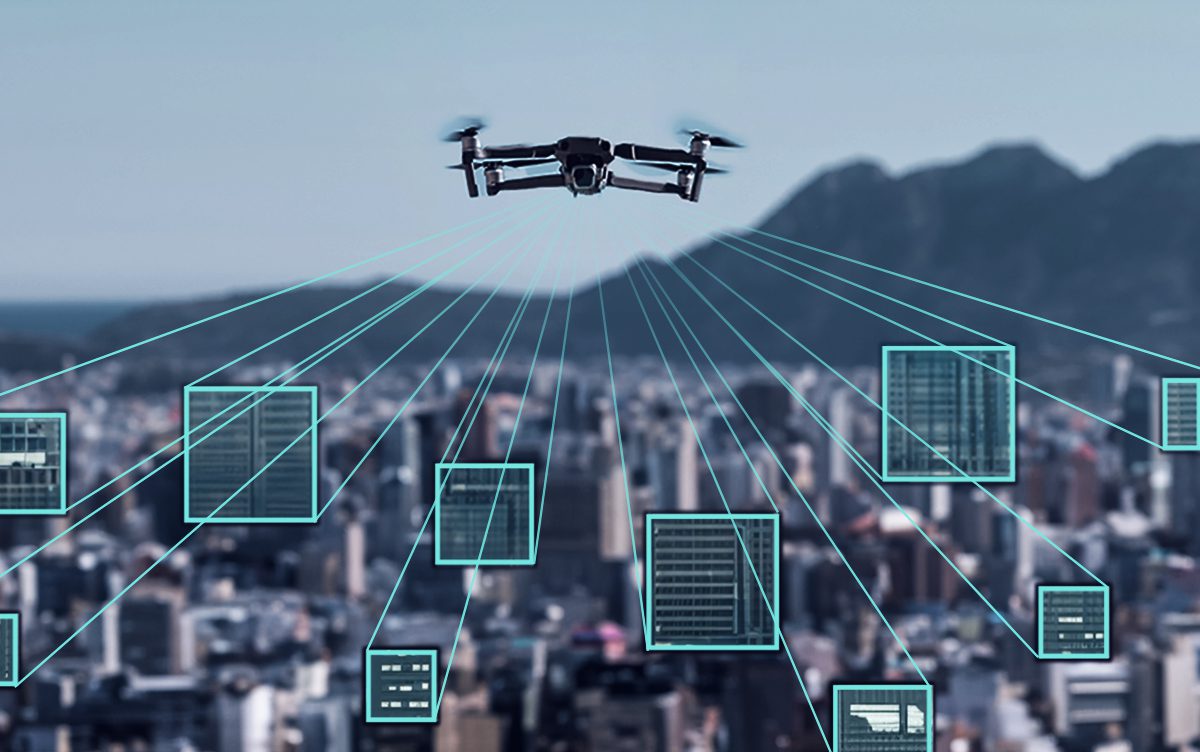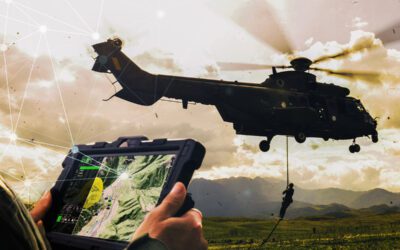The advent of reliable drone technology has opened up a whole new field of surveillance, deploying UAV or Unmanned Aerial Vehicles as ‘eyes in the sky’. Utilised for both military and civilian purposes, UAV surveillance isn’t just a matter of watching the movement and/or actions of people from a covert location. It can also include a wealth of uses as diverse as farming, land surveillance, and even studying topics as complex as crowd dynamics.
In this article, we’ll explore the history of UAV surveillance, examining how the technology emerged and its evolution in recent times. We’ll also explore its uses, including using drones for surveillance in military and civilian contexts.
We’ll also delve deeper into the features of UAV surveillance drones, their benefits and limitations. And finally, we’ll look at the future of drone surveillance technology, asking where we go from here and how this technology can be most effectively applied to the modern world.
But first…
What is a UAV?
A UAV is an unmanned aerial vehicle that does not carry a human operator. However, UAV drones can be operated remotely by a human or pre-programmed to fly autonomously to cover a specific target area. At all times, human operators monitor the UAV to ensure it does not deviate from its course or malfunction.
UAVs can carry both lethal and non-lethal payloads ranging from ordnance to cameras, depending on the requirements of the operators. They tend to bristle with high-tech sensors to give the data collators and operators a wealth of information in both visible light and non-visible light spectrums.
People often ask if there is any difference between a UAV and a drone. The truth is that the term ‘drone’ applies to any UAV capable of either remote-controlled or autonomous operation. Drones or UAV surveillance equipment forms part of a UAS or Unmanned Aerial System which includes the ground-based operations and the input of remote operators, including programmers. Then, there are toy-drones too, that operate solely via remote control. They distinguish themselves from professional drones, which possess the capability to autonomously execute flight plans-a feature not available to toy-drones.
A history of UAV surveillance – How did this technology emerge and evolve?
UAV surveillance is not a new concept, and its roots go back much further than you’d expect to the 1800s, when balloons were used as floating bombs, with extremely limited success. Scientific luminaries such as Alfred Nobel and Nikola Tesla both experimented with attaching cameras to balloons or rockets, with Tesla achieving notable success during a demonstration in 1898, where he used a radio-controlled boat to wow the crowds in Madison Square Garden.
Drones really started to emerge during the build-up to the Second World War, when both the UK and the USA started work on the ‘Queen Bee’ De Havilland DH.82B radio-controlled drone. It would set the tone for a military passion for unmanned surveillance equipment that has remained part of strategic planning right up to this day.
Fast-forwarding to the modern age, the first Predator Drone was developed in 1996, providing the military with a weaponised aerial platform that could be deployed into any theatre without putting human operators in harm’s way. 2006 saw the first use of UAV surveillance in a civilian context, when drones were used for Search & Rescue after the devastating effects of Hurricane Katrina. The ability of Predator drones to collate information such as heat signatures from up to 10,000 feet demonstrated the versatility of using drones for surveillance in a wide range of contexts.
The Coronavirus pandemic saw drones used to ensure social distancing and quarantine compliance through to delivering vital medical payloads to remote communities. It’s this huge range of applications that makes the use of drones such an important part of our technological timeline, stretching forward into the future too.
Different types of UAV surveillance technology
As drone technology has moved on, the sheer variety of different types of surveillance drones has increased exponentially. From tiny drones that have limited range but can infiltrate the smallest spaces to large-scale military surveillance drones that can carry out long-range and high-altitude operations, the technology is constantly adapting to fit new and more diverse needs.
Small drones – quick and nimble
Small drones are those that can weigh even less than 250 g. Not only can they operate independently but can also form ‘drone fleets’ where multiple small drones act together collectively to cover a wider area. A drone fleet management system allows operators to coordinate the actions and activities of each drone to create an aerial surveillance system that’s particularly effective in confined urban environments. Small drones, both singularly and as part of a fleet, are excellent for search and rescue missions in a disaster zone such as an earthquake-impacted town or city.
Large military surveillance UAVs
The use of UAVs in the military is well documented. As well as carrying surveillance equipment, these large drones can also deploy both lethal and non-lethal payloads with astonishing accuracy. All of this can be achieved without risk to the human operator, who is often thousands of miles away. This is the biggest advantage of large military surveillance UAVs – their range.
These vehicles are designed to cover vast distances and maintain operations for much longer periods. Their larger size means a greater ability to carry a bigger payload, as well as travel at higher speeds for longer. Larger military surveillance UAVs can utilise vertical take-off, while long-range versions may require a short runway to become airborne.
Uses for surveillance UAVs
As previously mentioned, the applications for surveillance drones of all types are vast, both for military and civilian operators. Putting aside the military uses for a moment, it’s worth looking at non-combative applications for both small and larger drones.
One of the biggest advances with surveillance drones in recent years has been the inclusion of multi-spectral scanning and photography, covering not just visible light bands, but non-visible bands as well. This can include both infrared and UV spectrums, allowing a huge amount of data to be gathered quickly. In turn, this makes the use of UAVs both practical and beneficial to a wide range of non-military users.
These groups include farming and land surveying, as the multi-spectral imaging equipment onboard can give surveyors a far more in-depth analysis of everything from the topography of the land to crop performances and water table positions. This can help farmers and landowners manage their property far more effectively. As our climate changes, it can also give ‘snapshots’ of where potential problems could arise in the future, such as areas at risk of flooding or the effects of drought, coastal erosion and so on.
For law enforcement, the use of surveillance drones is a ‘no-brainer’. The security implications as well as using drones for surveillance, target location and identification are part and parcel of modern security and law enforcement operations, and drones are being deployed daily across the world. From traffic management to crowd control during major events, carrying out searches for missing persons or helping direct ground crews without the use of an expensive helicopter mean that surveillance drones are a key inclusion in modern law enforcement operations.
For Search & Rescue teams, drones are becoming essential and are literally helping to save lives. Thanks to the fact that modern drones can now carry sensors that detect body heat and can also work in low light thanks to infrared technology, those lost in remote locations such as on mountain passes or after earthquakes can be found much more quickly and easily. The drones can direct the S&R teams to the exact locations of victims, allowing them to use their time more effectively and get to those in trouble in a much shorter time.
UAV surveillance features
The early drones carried a basic camera and very little else. However, as technology has become miniaturised, it’s much easier to pack a lot more surveillance equipment onto even a small drone, expanding its effectiveness.
Where once the best you could hope for would be a camera with 1080p resolution, today’s surveillance drones include a plethora of surveillance features including:
- Object tracking
- Terrain mapping
- Visual line of sight
- Hyperspectral imaging
- Thermal imaging
All of these can be enhanced by the use of Augmented Reality programs and packages such as the innovative FlySight software systems, allowing users to maximise the amount of information they can extract from the data provided by overlaying and mapping known reference points on top of terrain mapping or hyperspectral imaging, for example.
The benefits of using UAVs/drones for surveillance tasks
- They’re lightweight – Small to medium-sized surveillance drones come in at between 3-10kg and even the inclusion of additional surveillance equipment will not take a smaller drone to much over 11kg.
- hey’re easy to deploy – Operators can deploy a lightweight UAV in seconds. Because of their compact size, they can be carried in the back of a truck and deployed instantly whenever the operator reaches an appropriate location.
- They can work in teams – Drone fleets can be synchronised to work as a ‘team’, vastly expanding a potential surveillance area or splitting a search area into a grid pattern to maximise efficiency.
- They use intuitive technology – Training drone operators is relatively easy, as the equipment used to control a drone is familiar to most surveillance professionals.
- They’re stealthy – Small drones are incredibly compact and can still collate sufficient data even when flying at relatively high altitudes. Because of the low noise output, drones can be used to collect covert data without observation.
Limitations of surveillance UAVs
As useful as surveillance drones are, they do still have their limitations.
- Limited operating time – Drones, especially smaller ones, have a very limited operating time, sometimes less than 20-30 minutes of airtime before the batteries either need to be replaced or recharged. Taking into account the deployment and retrieval time, this can limit operational time over any target area to just a few minutes.
- Vulnerable – Drones are made from lightweight plastics for a good reason, but the advantages of having a lighter drone are countered by the drone’s vulnerability to damage during operations.
- Susceptible to weather conditions – lightweight drones in particular are vulnerable to weather conditions and cannot operate effectively in high winds or heavy rain.
- Susceptible to hackers – Because drones operate on set frequencies, it is potentially possible for a determined hacker to access the operating frequency and either disable, crash or otherwise put the surveillance drone out of action.
- Expensive – Highly technical drones packed with state-of-the-art technology such as multispectral imaging cameras can represent a considerable financial investment. As they are vulnerable to damage, it is worth considering other aerial platforms and how they may be able to carry out the same job as effectively as a drone, but for a lower risk and cost ratio.
Cost guidelines for UAV surveillance
Cost is, naturally, a significant quantifier when considering incorporating UAV surveillance drones into your overall operational framework. Those costs will depend on a variety of variables including:
- The type of drone – the larger the drone, the more expensive the initial outlay and the higher the running costs.
- Its capabilities – if you’re using drones for surveillance, there is no point in buying an ‘entry-level’ model. You will need to ensure that it has the capabilities to carry out missions and deliver the required data.
- The intended use.
- Ground-based operational considerations.
- Fusing surveillance drones into an existing operations system, including incorporating augmented reality technology and grandfathering over operational systems.
As well as the procurement of drones and their onboard technology, other operating costs have to be taken into consideration, including the life cycle costs such as fuel, system support, spares and depot maintenance, as well as operating personnel costs. If you are considering incorporating surveillance drones into your operations, you will need to carry out a bottom-up analysis of the overall costs, not just of the initial purchase, but any future upgrades, additional payload technology and data analysis equipment. After all, the information a drone captures is useless unless it is possible to interpret it quickly and accurately, so it is vital to consider the peripheral costs as well as the hardware costs.
The future application of surveillance UAVs – What does the technology of the future look like?
From monitoring the migratory patterns and population of penguins in Antarctica to performing Search & Rescue missions in some of the world’s most remote and inhospitable places, surveillance UVAs are continually given new avenues of use to explore. The technology has now been proven to work, and as operating systems become more integrated with augmented technology and AI, those uses will expand into a wider variety of applications. Water management companies are using them to fine-tune their reservoir management systems, responding almost instantly to changing water levels to keep everything from turbines turning and household taps flowing.
Tactical drones are now utilising gimbles that can stay focused on a target with the minutest of corrections, as well as incorporating Regions of Interest that can close down a target’s exact location using visual detection and object tracking.
Battery technology is the next major area of research, and as power packs become more reliable and longer lasting, drones will be able to stay airborne and operational for much longer periods, increasing both their range and operational capabilities.
The use of surveillance drones in the utilities will continue apace, including in the oil and gas industry. Not only will this enable managers to identify leaks much more quickly, but it also reduces the risk to personnel too, as the drones become their ‘eyes’ on top of dangerous stacks.
In fact, there are very few scenarios where drones cannot play a part in the future. With miniaturisation reducing the size and weight of payloads, smaller drones will be able to carry more analysis technology such as multi-spectral imaging cameras to collect ever greater amounts of data.
FlySight leading the way in drone security surveillance technology
At the cutting edge of surveillance drone technology is FlySight. Our augmented reality software is not only intuitive and user-friendly, but is constantly evolving to keep pace with both military and civilian demand. Our platforms are designed for your surveillance drones, working symbiotically with them to create aerial platforms that have far greater versatility and practicality.
Contact us in confidence to find out more.
Read other three articles about some FlySight activities with UAVs:
🔗 OPENSIGHT & Phase One P3 100MP is the optimal sinergy for target detection & quantifciation
🔗 UAV | FlySight gives a hexacopter for training
🔗 Enhanced Automatic Target Recognition with high-quality digital imaging capture




